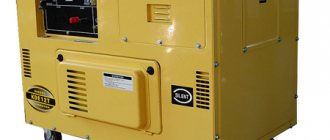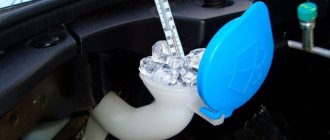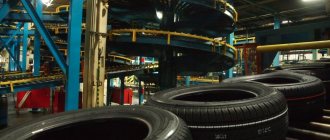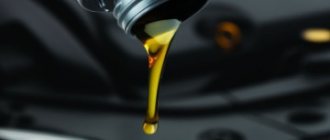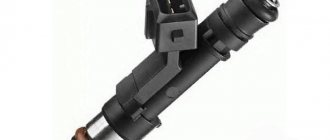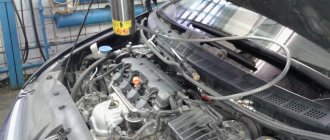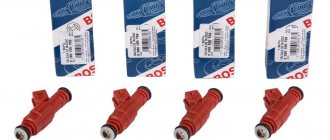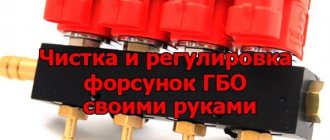The fuel injector is the most important part in the design of every car. Not a single modern passenger car can do without it, including the cars of the Volzhsky Automobile Plant of the tenth family. Injectors (VAZ 2110-2114) are used to atomize fuel due to high pressure, which amounts to several atmospheres. In this article we will learn how to determine the malfunction of this spare part and how long it takes to replace and clean them.
Service life
Now, probably, every Russian motorist knows what “quality” fuel he puts into the tank. The gasoline that is sold at gas stations for 30 rubles per liter cannot be called pure. In any case, it will contain a certain percentage of sulfur and impurities, but exactly how much of it will be in gasoline depends on the integrity of the company. As practice shows, fuel injectors (VAZ 2112-2114) need thorough cleaning after 20-30 thousand kilometers. Therefore, they need to be cleaned at least once a year.
Of course, there is no need to wait until another 20 or 30 thousand kilometers are added to the meter needle (perhaps this spare part will last another 40 thousand), since their exact service life is always different. And in order to notice a malfunction in time, you need to know certain signs by which the car behaves strangely. These include the following factors:
- The engine suddenly stalls at idle.
- Average fuel consumption increases by 10-30 percent.
- The machine cannot produce the power it developed before.
- The speed of the car either increases or decreases.
- Exhausts have become more polluted.
If you notice at least one of these signs, it means that the injectors on your VAZ need cleaning. However, before starting work, it is necessary to diagnose the car and only after that (if necessary) clean it. Why "if necessary"? The fact is that not only VAZ injectors, but a number of other units and components can show similar signs. Therefore, there is no need to do anything ahead of time.
As for diagnostics, of course, it needs to be carried out at a service center. But you don’t have to clean VAZ injectors there - you can do this process yourself. If you give your iron friend a few hours of free time, you can save about 1.5 thousand rubles.
What changes after the injectors are cleaned?
In this case, VAZ will get rid of all the problems that overtook it before the repair. After this process, you will notice that the car begins to consume less gasoline, the engine no longer stalls, the speed does not jump, and the power will increase significantly. In winter, the engine will start more smoothly, and the acceleration speed may also increase. It should also be remembered that the effectiveness of cleaning directly depends on the degree of contamination - the more accumulations there were on the injectors, the more problems with the operation of the gasoline engine will be eliminated at the output.
Fuel injection has undeniable advantages over the carburetor principle of mixture formation. First of all, this means more accurate dosing of fuel, and therefore greater efficiency and acceleration of the car and less toxicity of exhaust gases. However, the main executive part of the injection system - the nozzle - operates under difficult conditions and is therefore very demanding on maintenance.
Nozzle (injector) is a controlled electromagnetic valve that provides dosed fuel supply to the engine cylinders. There are injectors for central (single-point, mono) and distributed (multi-point) injection.
The control unit is an electronic unit that controls the injection system, in particular the operation of the injectors.
Injector structure: a – single-point injection nozzle, b – distributed injection nozzle 1 – filter, 2 – electrical connector, 3 – electromagnet winding, 4 – injector body, 5 – core, 6 – valve body, 7 – valve (b – valve needle ), 8 – sealing ring, 9 – spray hole.
Fuel is supplied to the injector under a certain pressure (depending on the engine operating mode). Electrical impulses supplied to the injector solenoid from the control unit actuate the needle valve, which opens and closes the injector channel. The amount of fuel sprayed is proportional to the pulse duration specified by the control unit. The shape and direction of the spray torch play a significant role in the process of mixture formation and are determined by the number and location of the spray holes.
Let's find the differences
For an engine with multipoint injection, the injectors are located in the intake manifold, closer to the intake valves. The temperature and pressure in the pipeline are low, as is the fuel pressure in the line.
With direct injection, the injector is located in the cylinder head and supplies fuel directly to the combustion chamber. During the combustion stroke, the injector nozzle is washed with hot gases, and the fuel pressure supplied by the injector exceeds 200 bar. Such high pressure is created by a high-tech fuel pump, the manufacture of which requires special materials and high surface finish. Any solid particles that enter the pump or nozzle can scratch the working surface and cause a loss of seal. Since the clearances between the valve needle and seat are also minimal, any deposits on them can lead to incorrect operation, loss of pressure, poor fuel atomization and coke formation on the injector nozzle. When removing all these deposits and varnish deposits, you should follow the medical commandment: do no harm.
We asked some questions to technicians from major companies, and here's what they said.
How do fuel additives affect the performance of the catalytic converter and oxygen sensors?
Bosch.
Additives may adversely affect their performance. Before cleaning, carefully read the manufacturer's recommendations.
Connecting an injector emulator
First of all, it is worth noting that it is best to entrust the connection of the 2nd generation LPG injector emulator to an experienced installer, so that if you connect it yourself, you will not damage the car’s electronics.
When connecting the device yourself, be sure to check the following points:
- Most gasoline injectors have a resistance of 100 ohms. Make sure that the device you want to install supports this resistance. Usually the resistance is indicated in the technical specifications of the product.
- Make sure that the connector on the emulator is the same as on your car.
- Make sure that the device supports the number of internal combustion engine cylinders you need.
- Carefully study the connection diagram; it should be included with the device.
The general connection diagram for the injector emulator is as follows:
- The injector emulator usually contains two wires - the blue wire is positive, the black wire is negative.
- The device itself is connected to the standard injectors, between them and the car's ECU.
- When +12 V is supplied, the emulator turns off the gasoline injectors and starts operating normally, taking into account the set delay time.
- +12 V is usually taken from the gas/gasoline mode switch button or solenoid valve.
conclusions
- The fuel system should be cleaned only when necessary - when error codes in the engine management system memory indicate a malfunction, and diagnostics, including cylinder endoscopy, confirm contamination of components.
- It is safer to use cleaning products recommended by the manufacturer.
- Did you dismantle the injectors for cleaning on a special stand? Be sure to install a new set of backup washers and O-rings.
- Cleaning the fuel system directly on the car with the connection of a washing unit can negatively affect the condition of the catalytic converter and oxygen sensors. With this procedure, it is impossible to accurately assess the degree of engine contamination. Any deposits that get into the neutralizer will cause local overheating of the ceramic honeycombs, and then their melting.
Which side is the positive side of the injector?
How to determine where the injector is plus and where is minus?
It makes absolutely no difference, because the principle of operation is the same as that of a relay. But in the diagrams, the plus is connected in the wiring harness block to the 2nd contact (look at the block from the contact side, holding the fixation bracket up).
I made a stand for checking and washing the injectors! - Control tests today. - I’ll post a photo later.
It doesn't matter where the plus is. The stand is cool. A can of carb flushing and a piece of hose have been helping me with this for 5 years without fail.

